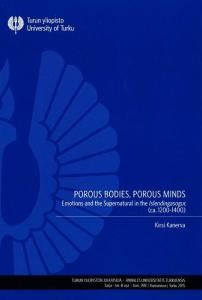 According to the medieval 13th and 14th-century Icelandic conceptions of emotion, emotions were physical in nature and they were regarded as movements of the mind. The mind itself existed within the body and it was often considered to be situated in the breast and associated with the heart.
According to the medieval 13th and 14th-century Icelandic conceptions of emotion, emotions were physical in nature and they were regarded as movements of the mind. The mind itself existed within the body and it was often considered to be situated in the breast and associated with the heart.
It was not only relationships and communication with the living people in one’s social environment that were expected to propel movements of the mind. Also the uncanny could be involved: operations of what most saga scholars have called ‘supernatural’ powers and beings could make the mind move. From medieval Icelandic perspective, the body and the mind that existed within the body were porous: supernatural forces could penetrate the boundaries of the body through eyes, mouth and other body openings. For instance, strong-willed people who had magical skills – such as smiths, people with other special skills or witches – could affect other people’s minds and emotions and, consequently, also their psychophysical condition.
Thought of a malevolent witch, for instance, were thought to be transmitted through wind. Such wind could penetrate the minds of others, e.g. through nose or mouth. As a consequence, an emotion-like reaction such as emotion, pain or illness could follow. In the 13th and 14th-century Icelandic Family sagas (Íslendingasögur), for instance, the upspring and experience of guilt that was associated with the recognition of moral responsibility could be represented through eye pain that was inflicted upon the experiencer in dream by the strong-willed human being or a supernatural being whom the experiencer had betrayed or insulted. The person suffering from eye pain could recover, if he ’atoned for his sins’ and made amendments. In other case, the eye pain that was regarded as a kind of supernatural ‘shot’ could result in the eyes bursting out, and finally: death. Traces of beliefs concerning similar supernatural ‘shots’ have been discovered also in earlier Anglo-Saxon material (Hall) as well as in later Scandinavian folklore (Lid).
Medieval Icelandic folk theory of emotion was not thoroughly thought of or unambiguous doctrine, however. Conceptions of the essence, origin and operation of emotions varied. The essence of emotions could also be considered material and be preserved in the heart. Anger, in particular, was considered to be a kind of energy and substance that could reside in the breast. As the amount of anger in the breast grew, the consequences of this were portrayed in the sagas as somatic changes: the body of the angry person became swollen.
Anger was also considered to be a kind of life power and energy. If a person died angry, the anger was expected to remain in the corpse. In such cases anger could reanimate the corpse and the deceased could return out of its own will to harass the living, not as an ethereal ghost but as a physical reanimated corpse. Such people had usually been known for their strong will already when they were still alive. In medieval Icelandic thinking, the mind of such strong-willed people could continue to exist after death. As a consequence, the deceased were considered conscious of what was going on around them and could react to things that had happened after their death. When they appeared, they elicited fear, especially in people who were regarded as weak. In fact, ‘supernatural’ beings, such as the restless dead, were expected to appear especially in such social environments where somebody had broken norms or betrayed someone, or the social equilibrium was shaken in some other manner.
One option to protect oneself against the supernatural forces was to live and act according to the norms and expectations of the society. It was good for people’s wellbeing if they could control themselves. Some emotions, such as fear, made people vulnerable to supernatural influences, since the body boundaries of a frightened person were thought to open. According to medieval Icelandic thinking, only those people who were mentally strong enough could keep their body boundaries intact and resist the external influences. Experiencing the supernatural and uncanny was ordinary, but being affected by the supernatural was considered a weakness.
The example of eye pain mentioned above also suggests that in Íslendingasögur movements of the mind were discussed in ways that do not immediately open up to modern readers and researchers. The inner state of a human being was not described directly. Only what could be seen by one’s own eyes was depicted, such as somatic changes, or heard by one’s ears when people spoke or composed poetry. The first expression is, therefore, that Íslendingasögur contain only few emotions. However, saga writers did have alternative ways to discuss and portray emotional atmospheres in various situations. Although the restless dead and the supernatural agents that caused eye pain were part of the social reality of medieval Icelanders (and all or at least many believed in their existence) they were also understood as alternative discourses or emotions – ways to discuss the inner state of people that could not be perceived through senses.
For example, in Íslendingasögur it is sometimes told of men who had a bad relationship with their father and for this reason lacked their approval, blessing and both mental and material support. In the medieval Icelandic context, losing or lacking the support of one’s father and male kinsmen was a serious drawback. The individual’s wellbeing and success was dependant on the networks that he had succeeded in gaining through kinship and marriages. These networks were his shelter and life insurance and guaranteed that even after death his honour would remain and his descendants would prosper. Clashes and conflicts with significant male relatives and especially the father was an occurrence that indicated destabilization of social order. In such situations the social status of an individual became indeterminate, i.e. he drifted into a socially liminal space, in which he was still his father’s son, but lacking the father’s support.
Although we could expect that this situation affected also the person’s emotional life, in sagas it is not implied at any instance that there would be some emotional turmoil. It is not told in what kind of mood the person was or what was going on inside the man’s and his father’s mind, what they felt and what they thought. We can read of their actions or things they leave undone and discussions in which their disagreements are put into words. The deeds of the conflicting parties are not psychologized, and the use of emotional words is nearly nonexistent. Later we may be told, however, how the son encounters a malevolent restless dead and is forced to wrestle with it until he is able to decapitate the corpse. After the event the man may continue his life, now known to have accomplished a heroic deed and respected by his community. Or, if things turn out worse for him, the restless dead succeeds in laying his evil eye on him before the decapitation, and as a consequence, the saga recites that the man was known to have been a man of misfortune and being constantly afraid of the dark where he could always see the horrible eyes of the cadaver that had moved his mind – i.e. that had frightened him – so enormously.
Even in the example above the restless dead would be liminal beings that were encountered in darkness, at nights, in winter, in foggy conditions, in caves and mounds – in spaces and situations when the vision of people was expected to be somehow impaired. However, although the restless dead did not directly reflect the inner state of the man who was in a socially liminal position, they were part of it – like tokens of the presence of something that could not be seen in broad daylight but was there, being simultaneously absent, something that belonged to the past like the deeds done but preserved in memory, and thus present in thoughts. The restless dead were in liminal spaces, dead but alive. They were the past in the present and objects that the man in a socially liminal space needed to encounter and destroy, in order to attain equilibrium and to prosper as a member of the society. If unsuccessful, the man was haunted by the look of the past for the rest of his life.
Written by Kirsi Kanerva
***************
The PhD thesis Porous Bodies, Porous Minds. Emotions and the Supernatural in the Íslendingasögur (ca. 1200–1300) by Kirsi Kanerva was publicly examined in the University of Turku in January 31, 2015.
Literature
Hall, Alaric. 2005. Getting Shot of Elves – Healing, Witchcraft and Fairies in the Scottish Witchcraft Trials. Folklore 116:19–36.
Hall, Alaric. 2007. Elves in Anglo-Saxon England – Matters of Belief, Health, Gender and Identity. Woodbridge. (Anglo-Saxon Studies 8).
Lid, Nils 1921: Um finnskot og alvskot – Eit umråde av norsk sjukdomsmagi. Maal og Minne, pp. 37–66.
Links
Order the dissertation from UTUshop
Read the electronic publication in Doria (articles not included)



